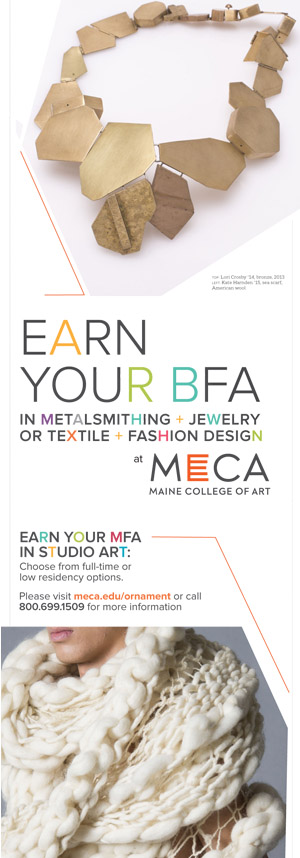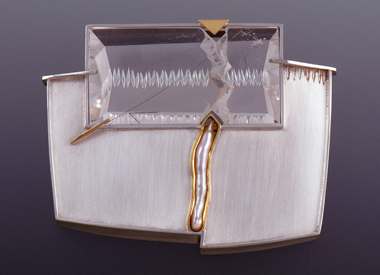
Eleanor Moty
A Master Metalsmith
Her goal is a consummate design matched by craftsmanship so exacting that it disappears into the background.
A line of peaks and valleys—like a high-frequency wave registering on an oscilloscope—cuts across a rectangular, crystalline void in sharp articulation of geometry. Worming its way into the icy perfection of this right-angled realm, a lustrous larval element outlined in bright gold asserts the equally compelling role of the organic in aesthetic expression. Eleanor Moty’s “Fissure” brooch is a study of complementaries: light and dark, regular planes and unpredictable curves, the measured architecture of reason and the erratic meanderings of nature. Enclosed in a frame of silver strips, the varied elements of the brooch are arranged with the confident finality of a compositional sense backed by the authority of universal aesthetics. The composition appears in some ways inevitable, as if drawn into place under a magnetic influence that naturally joined polarities and repelled duller conditions of sameness. Though teeming with implications of energy and even conflict in its various regions, the composition in its entirety is a model of resolution: a balanced expression of the kind of mastery of both materials and visual form that is content to allow the perfection of the object to take precedence over the assertion of the artist. This mastery was
This mastery was recently highlighted at the National Ornamental Metal Museum in Memphis, Tennessee, which honored Moty as the 2012 Master Metalsmith and hosted her most important retrospective to date. What emerged from this extensive exhibition was the picture of an artist who composes from parts rather than seeks to impress surfaces with signs of expression, touches the infinite of the universal rather than withdraws into the recesses of autobiography, and walks the expansive lines and planes of non-objective space rather than traces the intricate features of nature in close representation. When Moty confronts nature it is not with the intention of uncovering sources of art but rather of confirming the ubiquity of an aesthetic with which she is already well acquainted. Nature, in other words, must measure up to the expectations of art if it is to find a place in Moty’s work. At the same time, for more than twenty years natural elements have been central to her brooches, each of which begins with a carefully selected stone. “When I look for the stones,” she explains, “I’m already designing in my mind, so there are many that I reject. From twenty stones I might only select one.”
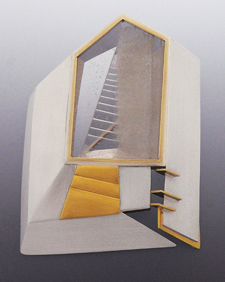
The stones, anchors for Moty’s constructions, are most often fantasy-cut rutilated quartz (the needle-like inclusions resemble thin rods of gold) or tourmalinated quartz, which carries in its transparent body black filaments that float like pencil lines in space. In the early 1980s, when Moty largely ceased making the electroformed and photo-etched work that built her early reputation, she began cutting her own stones as simple slabs for use in brooches. Then a discovery at the 1988 Tucson Gem and Mineral Show set the stage for more than two decades of distinctive work. “I discovered a large and unusual barrel-cut stone that I used for “Columnar” brooch,” she recalls. “It was quartz with wispy lines of tourmaline in it. Over the next decade I hunted down those kinds of stones and in 2004 met Tom Munsteiner, who was working with quartz crystals. “Interior” brooch was the first piece using the wonderful one-of-a-kind stones that Tom was cutting.”
“It is significant that Moty, who also favors cuts by the Idar-Oberstein lapidary artists Dieter Lorenz and Hermann Petry, conceives of her brooches not as settings for unique stones nor even as collaborations with some of the finest gem carvers in the world. Rather, she views her relationship to the stones as paralleling that of these other masters. Each responds to traits inherent in the stones, raising them to meet the demands of art by revealing in their tiny inclusions visual rhythms that harmonize perfectly with an abstract and universal aesthetics of form. Moty’s response upon recognizing these affinities is to underscore them, working through a series of sketches toward a composition that will employ sterling silver, gold, lustrous black Micarta, and various accent stones or pearls to expand upon the visual qualities of the quartz and its inclusions. The result is a unity of parts into which the large fantasy-cut stone is carefully integrated. “When I combine pieces,” Moty asserts, “it’s almost like pulling a collage together.”
The pronounced three-dimensional qualities of both stones and metal planes in Moty’s work also make them strongly sculptural. Her method of constructing from parts closely parallels, on a smaller scale, the assemblage techniques of the modern sculptors in welded steel David Smith, Anthony Caro and Richard Serra. Among contemporary sculptors, however, Moty is drawn most to the work of Andy Goldsworthy, whose temporary in situ assemblages of leaves, sticks, moss, or ice often suggest a harmonizing of naturally occurring formal traits with the geometric qualities of a non-objective aesthetic. Moty also expresses admiration for artist El Anatsui, known for his monumental tapestries composed of salvaged washers, bottle caps, cut aluminum cans, and copper wire. “They’re amazing in their textures and planes, and the change of patterns,” she notes.
One of the key distinctions between sculpture and two-dimensional art is that the former offers the potential to employ light not simply for illumination but as an aesthetic medium in its own right. This potential became even more obvious to Moty as she worked with clear stones, especially after her discovery of Munsteiner’s creations and those of the other Idar-Oberstein gem carvers. After all, the artistry imposed on stones such as quartz by cutting or grinding their surfaces is entirely a matter of light manipulation. Through the size and angles of cuts and the relative roughness or smoothness of surfaces, a lapidary artist can coax a broad range of effects from an otherwise uniformly transparent crystal. (Some of the crystals are designed with a matte surface on the back that renders them translucent.) As Moty responded to stones that expertly managed qualities of light she began to recognize subtle changes in her treatment of the metal components of her own compositions. “I became much more concerned with light patterns,” she recalls. “That’s what was happening in the stones, all of these light patterns and changes of planes. That pushed me into treating the surfaces so that silver became six different shades of white by the way that the metal was bent and constructed. I’m thinking of light coming through the stone but also falling upon the planes. It’s not so much about light passing through windows. No, I think of it as light striking the surfaces of architecture.”
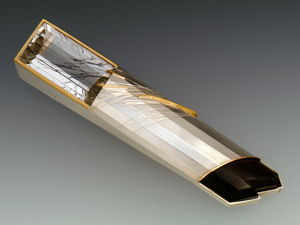
When the Abstract Expressionist painter Mark Rothko first beheld the solemn Doric ruins at Paestum in the late 1950s he declared that he had been painting Greek temples all of his life without realizing it. Moty experienced a similar revelation about her work’s architectural affinities, though as a gradual dawning rather than an epiphany. She made her first visit to the Steven Holl designed Chapel of St. Ignatius at Seattle University soon after its completion in 1997. Returning several times over the next few years, she began to understand why this small building exerted appeal for her beyond its immediate impact as architecture. “I walked in and was comfortable in the space,” she remembers. “I was fascinated by it. At first I thought it was just very interesting architecture, then about the third visit I knew why I liked it: because it’s my aesthetic as well. It has many different planes and angles, just as my work does. There are flashes, color coming across the surfaces and changes of white from the way the light falls on them. It was like being inside one of my brooches.”
Although the suggestions of staircase, walls and gable window in “Interior” brooch, the first of Moty’s works to incorporate a Munsteiner stone, could be interpreted as attempts to make concrete the impression of inhabiting architectural space, one should remember that stones are Moty’s starting points not because of their resemblance to other objects but rather because of the conduciveness of their inherent properties to interplay with the elements of a non-objective aesthetic. Perhaps the titles of Moty’s jewelry cloud this issue for the viewer, since they often suggest representation of specific experiences of the world, particularly of landscape and the seasons that leave their traces on it. However, titles such as “Waterfall,” “Ice,” “Comet,” and “Winter Light” are really more poetic afterthoughts than explanations of subject matter. “It’s just brainstorming,” Moty explains. “It’s practical to have titles rather than numbers because they’re easier to remember when someone is asking about a particular piece.”
Nonchalance about titles underscores the degree to which Moty’s work is non-narrative: she is concerned with content connected to abstract form rather than the particulars of experience. She emphasizes relationships internal to her brooches rather than ways in which her work might extend outward into the world through memory or association. Her goal is a consummate design matched by craftsmanship so exacting that it disappears into the background. To achieve this, attention to detail is essential. Every part, even the necessary functional elements, must participate in seamless necessity with the whole. “I always devise my own pinning mechanisms,” Moty states. “I integrate them aesthetically for two different aspects. The pin stem disappears when the brooch is worn, because it goes through the cloth, but when the brooch is displayed you can see it through the stone. When you turn the brooch over it’s pleasing to find that the angles and planes of the mechanism are of the same aesthetic quality.”
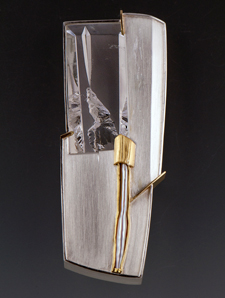
Uniformity of quality bolsters the autonomy, the self-sufficiency, that Moty cultivates in her works. She favors the brooch format so consistently because it frees her of obligation to consider the body of the wearer: the clavicle with which necklaces must contend and the fingers to which rings must conform. Brooches can be relatively large, but Moty never concerns herself with issues such as weight. This does not signify, however, that to her the wearer is of no consequence. On the contrary, Moty’s focus exclusively on the intramural aspects of the brooches—most importantly the aesthetic bonds between her metal compositions and the crystals to which they respond—offers wearers the same opportunity to link nature and aesthetics that she pursues. Those who purchase Moty’s jewelry select the patterns and textures of clothing to wear with them and even determine the way in which they are worn to advantage. “At an exhibition years ago I saw someone wearing one of my pieces on the shoulder,” she remembers. “It was such a revelation, because as she moved through the gallery the light flashed through the stone. The wearer shares the intimacy of the stone and the piece in the way that I saw them.”
The fact that the autonomy of Moty’s brooches is conducive to the sharing of experience between artist and wearer is even more consequential when the role of the gem carver is considered. The stone, with its interior intricacies, is a catalyst to aesthetic experience for all three individuals: Munsteiner, or another lapidary artist, who works the stone’s transparent or translucent surfaces to expose its inner secrets and manipulate its relationships with light; Moty, who recognizes in the distinctive arrangement of naturally occurring inclusions the traits of a universal aesthetic that can be complemented and highlighted by an equally significant composition of metal planes and accent stones; and the wearer, who discovers through Moty’s guidance that the stone offers an invitation to engage in aesthetic dialogue with nature. The success of Moty’s jewelry in linking this trilogy of aesthetic experiences is undoubtedly due to her restraint of desire to dominate the stone and distort it to the particulars of a personal aesthetic. Her goal is not the particular but rather the universal, and she seeks it through visual consonance with the stone. “In my work,” she asserts, “the kind of accent stones or black Micarta, and whether the metal is gold in color or white, is determined in reference to the main stone that I use. The way that I build my metal around it is always complementary to that stone. There’s an integration that’s complete.”
QUICK LINKS
 Glen R. Brown
Glen R. Brown
Glen R. Brown is a Professor of Art History and Associate Head of the Art Department at Kansas State University. An amateur’s interest in geology originally sparked his appreciation for contemporary jewelry, so he was naturally drawn to the work of Eleanor Moty, whom he describes as a “stone connoisseur” with a “masterful ability to bring out the visual poetry of inclusions in crystals by complementing them with her sophisticated compositions.” The occasion to write on Moty’s work arose from a visit to her 2012 Master Metalsmith exhibition at the National Ornamental Metal Museum in Memphis.
Keep rich and engaging content in your life, click here to subscribe today.
Our upcoming issue 37.4 contains
Nubian Jewelry
Kate Mensah
Philadelphia Craft Show
Some of Our Popular Articles

